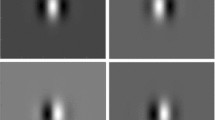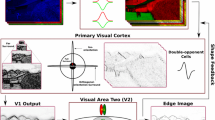Abstract
This chapter presents an image-processing algorithm for edge detection and orientation selection with discretely coupled nonlinear elements. The algorithm utilizes the nonlinear characteristic of the FitzHugh-Nagumo model and arranges the elements on an image grid system. Themodel is described with a pair of ordinary differential equations with activator and inhibitor variables, and exhibits mono-stable excitability. It was previously found that a grid system consisting of mono-stable nonlinear elements self-organizes pulses at crossing points between an initial activator distribution and a threshold level. In particular, the imposition of strong inhibitory coupling on the grid system causes stationary pulses at the crossing points. The algorithm presented here focuses on the phenomenon in which the grid system self-organizes stationary pulses at the crossing points. In addition, the algorithm introduces anisotropic coupling strength into the grid system; the coupling strength is decided according to the difference between the gradient direction of the inhibitor distribution and the specific orientation. An experimental section demonstrates the results of edge detection and orientation selection for artificial and real images.
Preview
Unable to display preview. Download preview PDF.
Similar content being viewed by others
References
Murray, J.D.: Mathematical Biology. Springer, Berlin (1989)
Hodgkin, A.L., Huxley, A.F.: A quantitative description of membrane current and its application to conduction and excitation in nerve. J. Physiol. 117, 500–544 (1952)
Zaikin, A.N., Zhabotinsky, A.M.: Concentration wave propagation in two-dimensional liquid-phase self-oscillating system. Nature 225, 535–537 (1970)
Busse, H., Hess, B.: Information transmission in a diffusion-coupled oscillatory chemical system. Nature 244, 203–205 (1973)
Kuhnert, L., Agladze, K.I.: Krinsky VI Image processing using light-sensitive chemical waves. Nature 337, 244–247 (1989)
Wang, D.L., Terman, D.: Locally excitatory globally inhibitory oscillatory networks. IEEE Trans. Neural Netw. 6, 283–286 (1995)
Chen, K., Wang, D.L.: A dynamically coupled neural oscillator network for image segmentation. Neural Netw. 15, 423–439 (2002)
Nomura, A., Ichikawa, M., Miike, H., Ebihara, M., Mahara, H., Sakurai, T.: Realizing visual functions with the reaction-diffusion mechanism. J. Phys. Soc. Jpn. 72, 2385–2395 (2003)
Ebihara, M., Mahara, H., Sakurai, T., Nomura, A., Osa, A., Miike, H.: Segmentation and edge detection of noisy image and low contrast image based on a reaction-diffusion model. J. IIEEJ 32, 378–385 (2003)
Kurata, N., Kitahata, H., Mahara, H., Nomura, A., Miike, H., Sakurai, T.: Stationary pattern formation in a discrete excitable system with strong inhibitory coupling. Phys. Rev. E 79, 056203 (2009)
Shoji, H., Iwasa, Y., Mochizuki, A., Kondo, S.: Directionality of stripes formed by anisotropic reaction-diffusion models. J. Theor. Biol. 214, 549–561 (2002)
Marr, D., Hildreth, E.: Theory of edge detection. Proc. Roy. Soc. Lond. Ser. B, Biol. Sci. 207, 187–217 (1980)
Canny, J.: A computational approach to edge detection. IEEE Trans. Patt. Anal. Mach. Intell. 8, 679–698 (1986)
FitzHugh, R.: Impulses and physiological states in theoretical models of nerve membrane. Biophys. J. 1, 445–466 (1961)
Nagumo, J., Arimoto, S., Yoshizawa, S.: An active pulse transmission line simulating nerve axon. Proc. IRE 50, 2061–2070 (1962)
Tyson, J.J., Alexander, K.A., Manoranjan, V.S., Murray, J.D.: Spiral waves of cyclic AMP in a model of slime mold aggregation. Phys. D 34, 193–207 (1989)
Turing, A.M.: The chemical basis of morphogenesis. Phil. Trans. Roy. Soc. Lond. Ser. B, Biol. Sci. 237, 37–72 (1952)
Gierer, A., Meinhardt, H.: A theory of biological pattern formation. Kybernetik 12, 30–39 (1972)
Castets, V., Dulos, E., Boissonade, J., De Kepper, P.: Experimental evidence of a sustained standing Turing-type nonequilibrium chemical pattern. Phys. Rev. Lett. 64, 2953–2956 (1990)
Kondo, S., Asai, R.: A reaction-diffusion wave on the skin of the marine angelfish Pomacanthus. Nature 376, 765–768 (1995)
Matsumoto, T.: A chaotic attractor from Chua’s circuit. IEEE Trans. Circ. Syst. 31, 1055–1058 (1984)
Chua, L.O., Hasler, M., Moschytz, G.S., Neirynck, J.: Autonomous cellular neural networks: a unified paradigm for pattern formation and active wave propagation. IEEE Trans. Circ. 42, 559–577 (1995)
Koenderink, J.J.: The structure of images. Biol. Cybern. 50, 363–370 (1984)
Perona, P., Malik, J.: Scale-space and edge detection using anisotropic diffusion. IEEE Trans. Patt. Anal. Mach. Intell. 12, 629–639 (1990)
Rekeczky, C.: CNN architectures for constrained diffusion based locally adaptive image processing. Int. J. Circ. Theor. Appl. 30, 313–348 (2002)
Barlow, R.B.: Jr, Quarles DA Jr Mach bands in the lateral eye of Limulus. J. Gen. Physiol. 65, 709–730 (1975)
Ferster, D., Koch, C.: Neuronal connections underlying orientation selectivity in cat visual cortex. Trends in Neurosci. 10, 487–492 (1987)
Heath, M., Sarkar, S., Sanocki, T., Bowyer, K.: http://marathon.csee.usf.edu/edge/edge_detection.html
Heath, M.D., Sarkar, S., Sanocki, T., Bowyer, K.W.: A robust visual method for assessing the relative performance of edge-detection algorithms. IEEE Trans. Patt. Anal. Mach. Intell. 19, 1338–1359 (1997)
Martin, D.R., Fowlkes, C.C., Malik, J.: Learning to detect natural image boundaries using local brightness, color, and texture cues. IEEE Trans. Patt. Anal. Mach. Intell. 26, 530–549 (2004)
Mrázek, P., Navara, M.: Selection of optimal stopping time for nonlinear diffusion filtering. Int. J. Comp. Vis. 52, 189–203 (2003)
Author information
Authors and Affiliations
Corresponding author
Editor information
Editors and Affiliations
Rights and permissions
Copyright information
© 2013 Springer-Verlag Berlin Heidelberg
About this chapter
Cite this chapter
Nomura, A., Mizukami, Y., Okada, K., Ichikawa, M. (2013). Image Edge Detection and Orientation Selection with Coupled Nonlinear Excitable Elements. In: Kyamakya, K., Halang, W., Mathis, W., Chedjou, J., Li, Z. (eds) Selected Topics in Nonlinear Dynamics and Theoretical Electrical Engineering. Studies in Computational Intelligence, vol 459. Springer, Berlin, Heidelberg. https://doi.org/10.1007/978-3-642-34560-9_21
Download citation
DOI: https://doi.org/10.1007/978-3-642-34560-9_21
Publisher Name: Springer, Berlin, Heidelberg
Print ISBN: 978-3-642-34559-3
Online ISBN: 978-3-642-34560-9
eBook Packages: EngineeringEngineering (R0)




